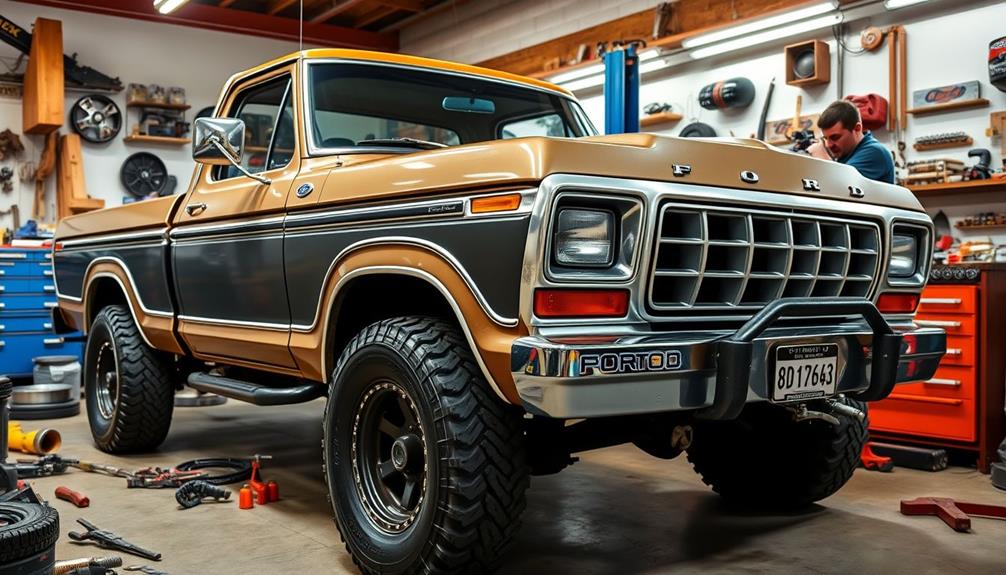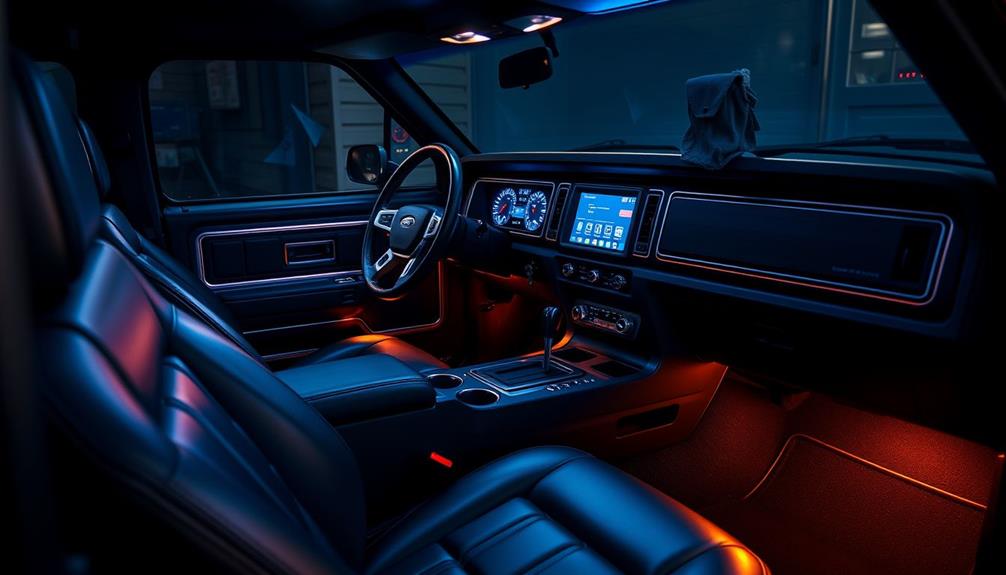Tuning your '79 Ford truck can truly transform it into a performance icon. By integrating modern components, like the 2012 Raptor parts, you'll enhance both its power and style. Custom modifications, from upgraded engines to tailored interiors, can markedly boost performance and comfort. Adding features like Bluetooth audio and modern suspension systems not only modernizes the ride but also retains its classic charm. Plus, with the growing market for customized classics, you might just find your investment increasing in value. There's so much more you can explore to maximize the potential of your classic truck. And if you’re looking for more inspiration, consider incorporating ford f150 ’96 tuning upgrades to take your ’79 Ford to the next level. With a wide range of aftermarket options available, you can easily find the perfect combination of performance and style to make your truck stand out. From upgraded exhaust systems for a more aggressive sound to performance chips for increased horsepower, the possibilities are endless when it comes to enhancing your ’79 Ford truck. Investing in these upgrades not only allows you to enjoy a more powerful and customized driving experience but also adds value to your classic vehicle.
Key Takeaways
- Customized classics blend vintage aesthetics with modern performance, enhancing both functionality and desirability.
- Popular builds, like the Raptor Plus Classic Ford, integrate modern components into classic designs.
- Restoration and customization can significantly boost market value and investment potential for classic Ford trucks.
- Modernized interiors and performance upgrades, such as the 5.0 Coyote V8, elevate driving experiences and safety.
- The classic Ford truck market is thriving, with increased interest from young buyers seeking unique, high-quality vehicles.
Customized Classic Concept
When it comes to the Customized Classic Concept, you're stepping into a world where modern performance seamlessly meets vintage charm. This innovative trend is all about creating customized classics that resonate with both classic car enthusiasts and those who crave modern capabilities.
Builders like Sweet Brothers Restomods exemplify this movement, marrying old-school aesthetics with cutting-edge engineering.
Take the Raptor Plus Classic Ford as a prime example. It merges the iconic 1979 F-150 body with 2012 Raptor components, resulting in a stunning 50/50 blend of classic style and modern performance.
You'll notice how careful selection of parts is key; integrating factory Raptor features while preserving the vintage look of classic trucks is no small feat.
As more collectors and enthusiasts seek out these unique builds, the demand for customized classics is on the rise. This surge could lead to waiting lists as builders endeavor to meet your expectations for a perfect blend of nostalgia and innovation.
If you're looking to stand out in the automotive world, embracing the Customized Classic Concept might just be the thrilling journey you're after.
Raptor Integration Process

Often, the Raptor integration process requires meticulous planning and expert execution to successfully combine a 1979 F-150 body with modern 2012 Ford Raptor components. Your goal is to achieve a perfect 50/50 blend of classic aesthetics and cutting-edge performance.
One major challenge you'll face is lengthening the Raptor frame to 151 inches to fit the vintage F-150 body while guaranteeing it maintains structural integrity.
Using the stock 6.2L engine and 6-speed transmission from the Raptor is essential for modern performance. You'll need to guarantee precise alignment and fitting throughout the integration process. Additionally, incorporating factory features from the Raptor, like keyless entry and a rear camera, enhances functionality without sacrificing that classic look you cherish.
To achieve the best results, collaborate with specialized body shops, such as Cool Customs Body and Paint. Their expertise will help you navigate modifications, guaranteeing custom paint and bodywork respect the vintage style while seamlessly integrating those modern elements.
With careful planning and execution, you can transform your classic ride into a high-performance icon that pays homage to its roots while embracing the future.
Classic Exterior Modifications

Classic exterior modifications for your '79 Ford can transform its appearance while preserving its nostalgic charm. One popular choice is adding Raptor fender flares, which seamlessly blend modern aesthetics with the truck's vintage design elements.
Collaborating with custom body shops like Cool Customs Body and Paint allows you to tailor modifications that enhance the classic look while integrating modern functionality.
Consider a custom blue and white PPG paint job to elevate the visual appeal without losing that retro essence. This upgrade not only beautifies your truck but also respects its original character.
Furthermore, integrating factory Raptor features—such as keyless entry and a rear camera—provides you with modern conveniences while maintaining the charming exterior you love.
Attention to detail during the modification process is essential. It guarantees that the original patina and character of your truck are respected, all while addressing structural integrity and durability.
With these classic exterior modifications, you'll not only enhance your '79 Ford's overall aesthetic but also enjoy the benefits of modern functionality, creating a truly unique performance icon that stands out on the road.
Modernized Interior Features

Transforming the interior of your '79 Ford into a modernized space enhances both comfort and functionality without sacrificing its vintage charm. The complete Raptor interior installation introduces contemporary seats that cradle you during drives, while a sleek dashboard and modern center console design elements elevate the aesthetic.
To keep you informed, upgraded gauges with LED displays maintain the original look but offer enhanced visibility and functionality, making it easier to monitor your vehicle's performance.
Soundproofing measures considerably reduce road noise, creating a quieter cabin that improves your overall driving experience compared to older models.
Safety is also a priority; the interior retains essential features like a seatbelt reminder chime, ensuring you meet modern safety standards.
Additionally, the custom layout includes Bluetooth-enabled audio components that are cleverly concealed, allowing you to enjoy modern connectivity options without compromising the classic vibe.
With these modernized interior features, you'll feel right at home in your '79 Ford, blending nostalgic elements with contemporary comforts, making every ride enjoyable and stylish.
Performance Enhancements Overview

When you think about boosting your '79 Ford F-150's performance, consider engine upgrades like the 5.0 Coyote V8 for a serious power boost.
Don't overlook suspension improvements, either; modern coilovers and axles can transform your ride quality and handling.
Together, these enhancements can make your classic truck feel brand new.
Engine Upgrades and Options
For those looking to enhance the performance of a 1979 Ford F-150, exploring engine upgrades and options is essential. The F-150 offers a variety of engine choices, with the 460-cubic-inch V-8 standing out for its impressive performance and collector appeal.
However, many enthusiasts prefer modern engines, like the 5.0 Coyote V8, which not only deliver significant power upgrades but also fit seamlessly into the classic design.
To further boost performance, consider performance modifications such as installing headers and high-flow exhaust systems. These upgrades can dramatically increase horsepower and torque, transforming your truck into a true performance icon.
Additionally, don't overlook the importance of a modern brake kit, especially if you're opting for larger wheel sizes. Enhanced stopping power is vital for safety and performance during more dynamic driving conditions.
Suspension and Handling Improvements
Upgrading the suspension on your 1979 Ford F-150 can make a world of difference in how it handles on the road. By installing modern components like coilovers or airbag systems, you'll greatly enhance ride quality and overall handling performance. These upgrades allow for better adjustment to various terrains, ensuring a smoother drive.
Incorporating upgraded sway bars is another game-changer. They reduce body roll during cornering, providing more stable and predictable handling characteristics.
Replacing worn-out factory shock absorbers with high-performance options can also improve damping control, resulting in better traction and comfort.
Additionally, consider installing new bushings made from polyurethane instead of rubber. This change enhances suspension responsiveness and durability, giving your truck a tighter feel during driving.
Upgraded steering components, such as a quick-ratio steering box, can elevate steering responsiveness and feedback, making your driving experience more engaging and precise.
With these suspension and handling improvements, your '79 Ford F-150 won't only look the part but also perform like a modern performance icon on the road. You'll enjoy a more confident ride, making every drive a pleasure.
Market Trends and Future Outlook

The classic Ford truck market is experiencing a notable surge, with F-150 values seeing a remarkable 20% increase. This trend reflects a growing interest among Ford truck enthusiasts, particularly for the Dentside F-Series.
Young buyers, who represent 40% of the F-Series market, are driving demand for customized classics that blend nostalgia with modern performance. As investors look for alternative assets, IRA rollovers to gold may also appeal to those interested in diversifying their portfolios alongside classic vehicles.
Restoration and customization can greatly boost market value, with unique builds often commanding high price tags due to their quality and craftsmanship. As you consider investing in a classic Ford truck, keep an eye on bespoke projects like those from Sweet Brothers Restomods, which are experiencing waiting lists due to rising demand.
Auctioning completed classic trucks has also become a popular avenue, further increasing desirability and market value.
The future looks promising for enthusiasts and collectors alike, as this upward trend showcases the enduring appeal of classic Ford trucks. If you're looking to get involved, now's the time to explore options and tap into this thriving market. Embrace the transformation of these classics, and you'll find that the potential for performance and investment is greater than ever.
Frequently Asked Questions
How Do I Put My Ford in Sport Mode?
To put your Ford in sport mode, locate the transmission shifter and move it to the "Sport" or "Manual" position. If your vehicle's equipped, this enhances throttle response and adjusts shift points accordingly.
Why Are 1973-1979 Ford Dentsides Called Dentsides?
You call the 1973-1979 Ford trucks "Dentsides" because of their unique body design featuring a pronounced indentation along the sides. This design enhances both aerodynamics and aesthetics, distinguishing them from earlier models.
What Is the Difference Between Ford Bumpside and Dentside?
The main difference between Bumpside and Dentside trucks lies in their design. You'll notice Bumpsides have rounded lines, while Dentsides feature angular designs, improved handling, and a wider cab for a more modern driving experience.
What Is a Dentside Ford?
You're looking at a Dentside Ford, a legendary beast from 1973 to 1979, flaunting that iconic body indentation. It's tough, robust, and packs a punch with engine options that'll make your heart race.
Conclusion
By tuning your '79 Ford, you're not just reviving a classic; you're painting a new masterpiece on the canvas of automotive history. Each modification is a brushstroke, blending nostalgia with modern performance, creating a car that roars like a lion yet retains the elegance of a bygone era. As you drive, you're not just in a car; you're steering a symbol of transformation, where the past and future collide on the open road, ready for any adventure.










